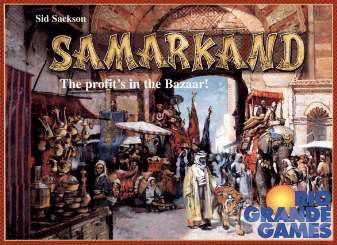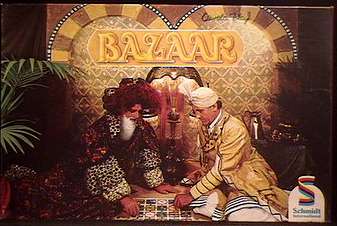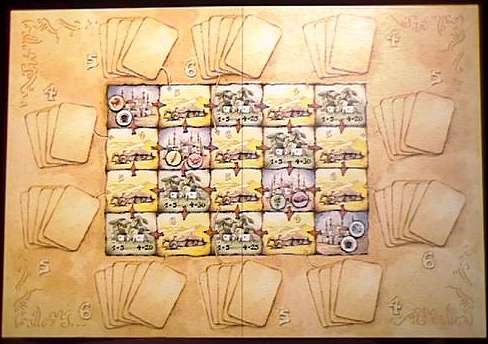
SAMARKAND
(aka BAZAAR II)
Bear with me now for a moment,
because this is a bit confusing. First there was a Sackson game called BAZAAR, which was published by 3M in 1968. Then, in 1986, Schmidt
published another Sackson game in Germany which, although it shares the trading
theme, has nothing else in common with the original BAZAAR, but decided that the
best name for this new game would be... yes, you guessed it,
"BAZAAR." To avoid confusion, this 1988 one is usually referred
to as "BAZAAR II." Click here for the rules to BAZAAR II, if
you're curious.

Then,
in 1998, an adaptation of BAZAAR II was published in
Germany by Abacus in 1998 under the name of SAMARKAND, and is now widely available in the US
from a terrific little company called RIO GRANDE
GAMES, which
has been going into partnership with German game publishers and
replacing the German language-dependent components with those in English. Jay
Tummelson, who runs RIO GRANDE, is doing a great service to American fans of
European games (which, sadly, most of Sackson's recent games qualify as, even
though the man lives in the Bronx!), and deserves to be encouraged and
supported.

In SAMARKAND, there are 6 commodities represented by cards: Grain, Fruit,
Copper, Carpets, Camels, and Jewels, with the Grain being the most common and
the Jewels being the most rare. Each player is dealt 7 cards
to start, and wanders around the city buying, trading, and selling these items
in an attempt to turn 200 Piasters into the 500 necessary to win. Take a look at
the picture of the very cool board. The arrows determine
where you can go on your turn. The yellow spaces are Nomad camps, in which
trading can take place. The green spaces are Oases, in which goods can be
bought. And the purple spaces are Cities, in which commodities can be
sold. Each commodity can only be sold in the proper city, as indicated by
the symbols in the circles on the city squares. And the more you have of
any one commodity, the more you get for them, which is why you run around trying
to get a lot of one thing before selling. Those arrows make navigation a
tricky procedure, but rather than just moving one square per turn, you always
have the option of rolling the special six-sided die, which has a backwards one
instead of a six. However, once you commit to rolling the die, you must
move that number of spaces.
It's a beautiful and engrossing game. With three players, it's usually
around 40 minutes, but with five it can take over an hour. There is an
expansion available for this game from Rio Grande, and apparently, it's based on
a variant that Sackson himself included in his original rules. Click here
to get the
ISFAHAN expansion for free from Funagain!
The main difference between
SAMARKAND and the original BAZAAR II is that in BAZAAR II, you rolled a
six-sided die and had to move the full amount each time. This made getting
around the board much faster, as opposed to the SAMARKAND way of being allowed
one free movement space, or the ability to buy a roll of the die. Also,
BAZAAR II uses colored plastic chips instead of the nicely themed cards you get
with SAMARKAND. And it's so much easier to remember that jewels are more
valuable and more scarce than wheat, than it is that blue chips are rarer than
green ones. I have no idea whether the adaptation from BAZAAR II
into SAMARKAND was made by Sackson himself or by Abacus, but it's a good one.
For my money, you're much better off with SAMARKAND. (Good thing, too,
because BAZAAR II is fiendishly difficult to get ahold of!)
Click to see if Funagain Games has a copy of
SAMARKAND
for you...
Moving
on
to some of the Great Books of Sid Sackson...
Home


